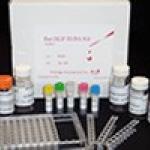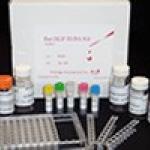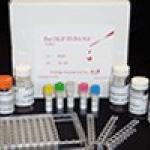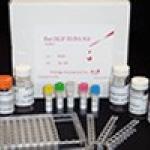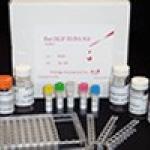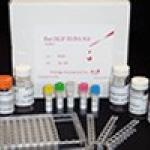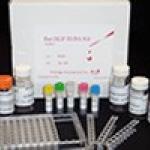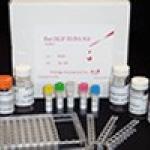-
Description:
Caspases are the executioners of apoptosis. These cysteine protease family consists of more than 10 related members characterized by almost absolute specificity for aspartic acid in the P1 position. Caspases are synthesized as inactive proenzymes comprising an N-terminal peptide together with one large and one small subunit.…
-
Specification:96TestDescription:
CASP10,a protein which is a member of the cysteine-aspartic acid protease (caspase) family. Sequential activation of caspases plays a central role in the execution-phase of cell apoptosis. Caspases exist as inactive proenzymes which undergo proteolytic processing at conserved aspartic residues to produce two…
-
Specification:96TestDescription:
Adiponectin, also known as adipocyte complement-related protein of 30kDa (ACRP30), is a secreted serum protein expressed exclusively in differentiated adipocytes. Studies indicated that decreased plasma adiponetin concentration is associated with obesity, insulin resistance , essential hypertension , inflammation…
-
Specification:96TestDescription:
Adrenomedullin(ADM) is a peptide associated with pheochromocytoma- a tumour arising from adrenal medulla. It was discovered in 1993. Adrenomedullin (AM) is a ubiquitously expressed peptide initially isolated from phaechromyctoma in 1993. Since its first report, studies examining the effects of adrenomedullin have…
-
Specification:96TestDescription:
Caspase-6 have been identified in numerous mammals for which complete genome data are available. Unique orthologs are also present in birds, lizards, lissamphibians, and teleosts. This gene encodes a protein which is a member of the cysteine-aspartic acid protease (caspase) family. Sequential activation of…
-
Specification:96TestDescription:
The active Caspase-3 ELISA measures active caspase-3 in systems that contain caspase-3 zymogen and other active caspases. Caspase-3 is a cysteine protease that cleaves substrates at the carboxyl terminus of aspartate residues. Active caspase-3 has two active sites and consists of two identical large and two…
-
Specification:96TestDescription:
The adenovirus is an ubiquitous pathogen of humans and animals. Adenoviruses are characterized by location inside the cell nucleus, common complement-fixing antigens and marked stability to environmental effects. Adenoviruses are endemic in all populations throughout the year. The infection is spread both through…
-
Specification:96TestDescription:
Antibodies directed against endothelial cells (AEA) occur during various pathological conditions. During allograft rejection, an antibody response against endothelial cells is mounted that may play a role in the effector phase of the rejection process. In several autoimmune diseases autoantibodies directed against…
-
Specification:96TestDescription:
Anti-filaggrin antibodies (AFA) have been found to be highly specific for rheumatoid arthritis (RA) but have also been observed in some sera from patients with juvenile chronic arthritis, systemic sclerosis, systemic lupus erythematosus and ankylosing spondylitis.
Anti-filaggrin antibodies (AFA) are among the most…
-
Specification:96TestDescription:
8-iso PGF2a has been shown to cause contraction of a variety of smooth muscle preparations including human myometrium, guinea-pig and human airways, rat renal and pulmonary vessels and rabbit pulmonary vessels. Where tested, the contractile actions of 8-iso PGF2a are blocked by thromboxane receptor (TP) antagonists…
 Description: Caspases are the executioners of apoptosis. These cysteine protease family consists of more than 10 related members characterized by almost absolute specificity for aspartic acid in the P1 position. Caspases are synthesized as inactive proenzymes comprising an N-terminal peptide together with one large and one small subunit.…
Description: Caspases are the executioners of apoptosis. These cysteine protease family consists of more than 10 related members characterized by almost absolute specificity for aspartic acid in the P1 position. Caspases are synthesized as inactive proenzymes comprising an N-terminal peptide together with one large and one small subunit.… Specification:96TestDescription: CASP10,a protein which is a member of the cysteine-aspartic acid protease (caspase) family. Sequential activation of caspases plays a central role in the execution-phase of cell apoptosis. Caspases exist as inactive proenzymes which undergo proteolytic processing at conserved aspartic residues to produce two…
Specification:96TestDescription: CASP10,a protein which is a member of the cysteine-aspartic acid protease (caspase) family. Sequential activation of caspases plays a central role in the execution-phase of cell apoptosis. Caspases exist as inactive proenzymes which undergo proteolytic processing at conserved aspartic residues to produce two… Specification:96TestDescription: Adiponectin, also known as adipocyte complement-related protein of 30kDa (ACRP30), is a secreted serum protein expressed exclusively in differentiated adipocytes. Studies indicated that decreased plasma adiponetin concentration is associated with obesity, insulin resistance , essential hypertension , inflammation…
Specification:96TestDescription: Adiponectin, also known as adipocyte complement-related protein of 30kDa (ACRP30), is a secreted serum protein expressed exclusively in differentiated adipocytes. Studies indicated that decreased plasma adiponetin concentration is associated with obesity, insulin resistance , essential hypertension , inflammation… Specification:96TestDescription: Adrenomedullin(ADM) is a peptide associated with pheochromocytoma- a tumour arising from adrenal medulla. It was discovered in 1993. Adrenomedullin (AM) is a ubiquitously expressed peptide initially isolated from phaechromyctoma in 1993. Since its first report, studies examining the effects of adrenomedullin have…
Specification:96TestDescription: Adrenomedullin(ADM) is a peptide associated with pheochromocytoma- a tumour arising from adrenal medulla. It was discovered in 1993. Adrenomedullin (AM) is a ubiquitously expressed peptide initially isolated from phaechromyctoma in 1993. Since its first report, studies examining the effects of adrenomedullin have… Specification:96TestDescription: Caspase-6 have been identified in numerous mammals for which complete genome data are available. Unique orthologs are also present in birds, lizards, lissamphibians, and teleosts. This gene encodes a protein which is a member of the cysteine-aspartic acid protease (caspase) family. Sequential activation of…
Specification:96TestDescription: Caspase-6 have been identified in numerous mammals for which complete genome data are available. Unique orthologs are also present in birds, lizards, lissamphibians, and teleosts. This gene encodes a protein which is a member of the cysteine-aspartic acid protease (caspase) family. Sequential activation of… Specification:96TestDescription: The active Caspase-3 ELISA measures active caspase-3 in systems that contain caspase-3 zymogen and other active caspases. Caspase-3 is a cysteine protease that cleaves substrates at the carboxyl terminus of aspartate residues. Active caspase-3 has two active sites and consists of two identical large and two…
Specification:96TestDescription: The active Caspase-3 ELISA measures active caspase-3 in systems that contain caspase-3 zymogen and other active caspases. Caspase-3 is a cysteine protease that cleaves substrates at the carboxyl terminus of aspartate residues. Active caspase-3 has two active sites and consists of two identical large and two… Specification:96TestDescription: The adenovirus is an ubiquitous pathogen of humans and animals. Adenoviruses are characterized by location inside the cell nucleus, common complement-fixing antigens and marked stability to environmental effects. Adenoviruses are endemic in all populations throughout the year. The infection is spread both through…
Specification:96TestDescription: The adenovirus is an ubiquitous pathogen of humans and animals. Adenoviruses are characterized by location inside the cell nucleus, common complement-fixing antigens and marked stability to environmental effects. Adenoviruses are endemic in all populations throughout the year. The infection is spread both through… Specification:96TestDescription: Antibodies directed against endothelial cells (AEA) occur during various pathological conditions. During allograft rejection, an antibody response against endothelial cells is mounted that may play a role in the effector phase of the rejection process. In several autoimmune diseases autoantibodies directed against…
Specification:96TestDescription: Antibodies directed against endothelial cells (AEA) occur during various pathological conditions. During allograft rejection, an antibody response against endothelial cells is mounted that may play a role in the effector phase of the rejection process. In several autoimmune diseases autoantibodies directed against… Specification:96TestDescription: Anti-filaggrin antibodies (AFA) have been found to be highly specific for rheumatoid arthritis (RA) but have also been observed in some sera from patients with juvenile chronic arthritis, systemic sclerosis, systemic lupus erythematosus and ankylosing spondylitis. Anti-filaggrin antibodies (AFA) are among the most…
Specification:96TestDescription: Anti-filaggrin antibodies (AFA) have been found to be highly specific for rheumatoid arthritis (RA) but have also been observed in some sera from patients with juvenile chronic arthritis, systemic sclerosis, systemic lupus erythematosus and ankylosing spondylitis. Anti-filaggrin antibodies (AFA) are among the most… Specification:96TestDescription: 8-iso PGF2a has been shown to cause contraction of a variety of smooth muscle preparations including human myometrium, guinea-pig and human airways, rat renal and pulmonary vessels and rabbit pulmonary vessels. Where tested, the contractile actions of 8-iso PGF2a are blocked by thromboxane receptor (TP) antagonists…
Specification:96TestDescription: 8-iso PGF2a has been shown to cause contraction of a variety of smooth muscle preparations including human myometrium, guinea-pig and human airways, rat renal and pulmonary vessels and rabbit pulmonary vessels. Where tested, the contractile actions of 8-iso PGF2a are blocked by thromboxane receptor (TP) antagonists…

